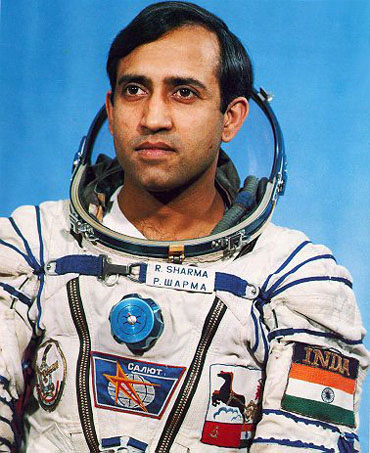In a Nation, that idolises heroes only from Cinema and Cricket, Squadron Leader Rakesh Sharma provided a change when he became the first Indian to venture into outer space. He flew in the Russian Spaceship Soyuz T-11. Rakesh Sharma was chosen out of hundreds of aspirants to undergo training with the Russians as part of their space programme. He spent some time on the Russian Space Station, the Salyut-7 before successfully returning to the Earth.
Born on 13th January 1949 in Patiala, Rakesh Sharma was a test pilot in the IAF. He was selected on 20th September 1982 to become a cosmonaut and was trained for 18 months for the eight-day trip. In 1984 he became the first Indian citizen to go into space when he flew aboard the Russian rocket Soyuz T-11. The take-off from Baikonur in Moscow on April 2, 1984 was a high point in Indo-Soviet relations. The Soyuz IT – 11 docked and transferred the three-member Soviet-Indian international crew which also included the Ship's Commander Y.V. Malyshev and Flight Engineer G.M. Strekalov (USSR) to the SALYUT-7 Orbital Station. The crew spent seven days aboard the Salyut Space Station during which they conducted scientific and technical studies, which included 43 experimental sessions.
The one thing that cosmonauts are trained the most is to cope with is zero gravity. For example, Sharma, who recently gave a lecture in Bangalore on the kind of training that is given to astronauts, recalled that they were all made to sleep with their heads lower than their feet. Sharma says that six months before the launch, he dropped the fitness regime that the other cosmonauts were following and did intensive yoga. This was to assess whether yoga helps people cope better with the lack of gravity. His work was mainly in the flelds of biomedicine and remote sensing.
Rakesh Sharma immortalised himself in Indian History and made his way into many Indians hearts by his answer to the then PM Indira Gandhiji's question on how India looked from outer space. He replied "Saare Jahan Se Achha" (The Best in the World). That was also a proud moment for millions of Indian TV viewers who watched India become the 14th nation to send a man to outer space.
Rakesh Sharma was awarded the Ashoka Chakra, for the successful completion of the Space Mission. His companions on the Soyuz T-11 Mission, Col Yuri Vasilevish Malyzhev and Col Gennady Mikhailovich Strekalov, both Russians were also awarded the Ashoka Chakra. It was the first and only time that the Ashoka Chakra was awarded to foreigners. He says he had no time to feel excited or worried in space. “There was so much hectic activity on board the spaceship, so many things that each of us had to do, that we literally had no time to sit around and stare into endless space...” The worst moment of his trip was when the Soyuz T-11, a single-use spaceship in which the procedure for landing was different, caught fire, recalls Sharma.
“The space capsule got burnt when it re-entered the earth's atmosphere. As the layers of atmosphere became denser, the surface friction became high and the spaceship began to burn off in layers. I can still recall... it was all so noisy.” As this was going on, Sharma and his fellow astronauts parachuted. "It was quite frightening to bale out of a burning spaceship. We had to parachute out over the desert of Kazakhstan." Rakesh Sharma later joined HAL as a Test Pilot, which involved testing the various aircraft being manufactured at Ojhar, near Nasik. He had a providential escape from a MIG-21 when he had to eject. He retired from the Indian Air Force as a Wing Commander. He has shown the world that Indians are fast catching up in space exploration.
The Columbia shuttle disaster, in which Indian-American Kalpana Chawla and six of her colleagues perished, has not deterred Wing Commander Rakesh Sharma. "I am quite willing to go into space again, in a space shuttle or a capsule... I do not mind who takes me either," says Sharma.



